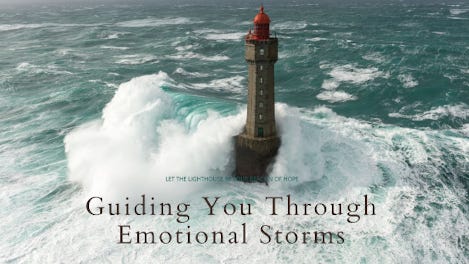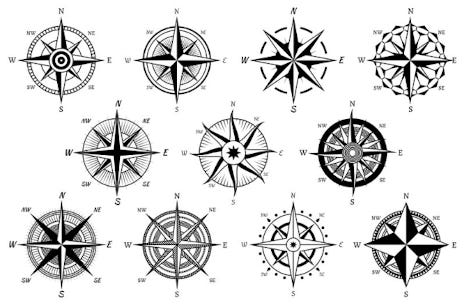Maps for the Seas Inside
Navigating the Emotional Ocean in an Age of Uncertainty
Maps for the Seas Inside: Navigating the Emotional Ocean in an Age of Uncertainty
An Invitation to Navigate Uncharted Waters
These essays offer maps for territory most people don’t know exists. The emotional geography of a world where old certainties have collapsed and new ones haven’t yet formed.
The ideas ahead stand on their own. They don’t require you to know my story to work with them. Like any good navigational tool, they’re designed to function regardless of who built them or why.
But if you find value in these frameworks (if the concept of emotions as forecast failures or the practice of reading your inner weather proves useful) you might wonder how such maps get drawn in the first place.
At the end, I’ll share the story of how I came to chart these particular seas: the decade of complete cognitive reconstruction that taught me to distinguish between the maps we inherit and the territory we actually inhabit. It’s the account of burning down a house of illusions and rebuilding with stronger materials.
The maps come first. The mapmaker’s journey follows; for those curious about how one learns to navigate by rebuilding from wreckage.
Ready to begin? The known world ends here.
Living on a Landscape of Mind
Your mind is a cartographer, constantly drawing invisible maps of what comes next
Every morning, you wake into a world built not from concrete and steel, but from expectation and memory. The coffee will taste right. The commute will take twenty-three minutes. Your boss will respond to emails within the hour. These mental charts guide you through each day so seamlessly that you barely notice them. Until one fails.
For centuries, mapmakers marked the edges of their charts with sea monsters and serpents. Not because they believed in them, but because they needed a way to warn: Here, the known world ends. Your emotions function the same way. Surprise, fear, frustration, awe; they are the creatures drawn at the boundaries of your inner maps, marking the moment when reality diverges from prediction.
Understanding this shift in perspective from viewing emotions as random interruptions to seeing them as navigational data; transforms how we move through an increasingly unpredictable world. Every feeling becomes a field report from the frontier between what we expected and what actually occurred.
When the Monsters Emerge: 2023-2025 as a Master Class in Forecast Failure
Reality keeps rewriting the rules faster than we can update our charts
The past three years have offered humanity a collective lesson in what happens when all our maps fail at once. Consider 2023, officially declared the hottest year in recorded history. For millions, this wasn't just a statistic. It was an emotional earthquake. Climate scientist Samantha Bova described the feeling as "nervous and concerned about where we're continuing to head," followed by "frustration" and "anger" because "we know so much about what's causing the planet to heat up".
The emotional responses weren't uniform. Research shows that younger people tend toward activating emotions like anxiety and anger that "compel you to do something," while older adults gravitate toward numbness, resignation, and sadness. Emotions that lead to more passive behavior. This wasn't random; it was the sound of different generational maps breaking in different ways.
Meanwhile, political polarization reached new heights, creating what researchers call "affective polarization;" the growing emotional divide between political tribes. By 2025, this divide had become so pronounced that 40% of Americans identified politics as a significant source of stress, with approximately 5% reporting they had contemplated suicide due to the political climate. The USC Viterbi study revealed how this emotional geography shapes behavior: people increasingly make decisions not based on merit, but in reaction to what their political opponents choose.
Economic uncertainty added another layer of navigational complexity. Consumer sentiment surveys from early 2025 showed Americans trapped between competing emotional forecasts: Republicans reported feeling hopeful (54%), confident (45%), and optimistic (44%), while Democrats felt concerned (58%), frustrated (49%), and anxious (43%). Yet both groups shared the same top worry: inflation, cited by 79% across party lines.
The Digital Disruption: When Algorithms Rewrote Our Social Maps
Technology shifted the territory beneath our feet while we were still walking
Perhaps nowhere was forecast failure more personally felt than in the digital realm. The November 2022 launch of ChatGPT created what researchers termed "AI anxiety," a widespread emotional response to the sudden realization that career forecasts spanning decades might need complete revision. Within months, 45% of knowledge workers reported anxiety about AI replacing their jobs, while simultaneously 60% expressed excitement about AI's potential to enhance their work.
This wasn't just workplace stress; it was existential cartographic crisis. People who had spent years building mental maps of professional competence suddenly faced the possibility that their core skills might become obsolete overnight. The emotional toll manifested differently across age groups: younger workers showed more adaptability mixed with competitive anxiety, while older workers experienced deeper grief over potentially "wasted" expertise.
Social media platforms provided another laboratory for forecast failure. When Twitter transformed into "X" under Elon Musk's ownership, millions of users experienced what psychologists called "platform grief;" mourning not just for lost features, but for disrupted social forecasts. Users had built mental models of how online communities functioned, how content would be moderated, and how their digital identities would be preserved. The platform changes violated these implicit contracts, generating widespread feelings of displacement and betrayal.
The Housing Market Paradox: Dreams Deferred and Recalibrated
The American Dream blueprint proved outdated in an age of impossible prices
The 2023-2025 housing market offered a particularly stark example of collective forecast recalibration. For decades, homeownership had been sold as the foundation of the American Dream, a predictable path from renting to buying, from starter home to forever home. But as mortgage rates soared above 7% and median home prices continued climbing despite economic uncertainty, millions found their life timelines suddenly unworkable.
The emotional impact was profound and generational. First-time homebuyers postponed purchases by an average of 2.3 years, forcing wholesale revision of life forecasts that had linked homeownership to marriage, children, and financial security. Mental health professionals reported increased anxiety and depression among young adults whose "housing grief" reflected not just financial disappointment, but the collapse of deeply held assumptions about how adult life was supposed to unfold.
Existing homeowners faced their own emotional turbulence. Those who had purchased homes with adjustable-rate mortgages found themselves trapped between unaffordable payments and negative equity. The resulting stress wasn't merely financial. It represented the failure of forecasts about stability, investment, and family security that had guided major life decisions.
This housing crisis revealed how deeply intertwined our emotional and economic forecasts truly are. When basic assumptions about shelter (humanity's most fundamental need after food and water) become unreliable, it creates ripple effects throughout every other prediction system we maintain.
The Architecture of Expectation
Every thought runs on invisible timelines and assumptions about tomorrow
Moving from these macro-scale disruptions to the personal level, we can better understand how forecast systems actually operate within individual minds. Your brain is a forecast engine, running millions of invisible simulations every day. Most operate below conscious awareness. Micro-predictions about traffic patterns, social responses, and weather changes. Others shape the grand arcs of your life: career trajectories, relationship timelines, health expectations.
These forecasts exist on multiple levels simultaneously. When you check your phone expecting a text from a friend, you're running at least three concurrent predictions: the micro-forecast (this specific message), the relationship forecast (how this friendship typically works), and the social forecast (how people generally communicate). When the text doesn't arrive, all three systems register the mismatch and emotion rushes in like water through a breach in the hull.
The COVID-19 pandemic provided a global example of what researchers call "forecast cascades," when the failure of one prediction triggers the collapse of others. Public health forecasts proved wrong, economic models failed, social assumptions crumbled. The result was what one expert described as widespread "anxiety, stress, and emotional distress" when "expectations were not met".
What makes this architecture particularly complex is that most forecasts operate below conscious awareness. You don't actively decide to expect your morning coffee to taste a certain way, or your commute to take a predictable amount of time. These micro-predictions form the invisible scaffolding of daily life, only becoming apparent when they fail and generate emotional responses.
The Ten Forecast Feelings: An Updated Navigation Chart
Every emotion signals a specific type of prediction error
Just as ancient mariners learned to read wind and wave patterns, we can learn to read the emotional signals that emerge when our predictions meet reality. Each emotion corresponds to a specific type of forecast violation, creating a reliable navigation system for emotional intelligence.
| Feeling | Forecast Violation | 2023-2025 Example |
| Joy | Better outcome than expected | Market rebounds defying recession predictions |
| Grief | Worse outcome than expected | Climate records breaking faster than projected |
| Anger | Something necessary didn't happen | Political promises unfulfilled despite clear mandates |
| Relief | A predicted bad outcome was avoided | Economic "soft landing" despite inflation fears |
| Fear | A predicted trouble may still materialize | Nuclear threats amid geopolitical tensions |
| Anxiety | Multiple forecasts conflict | Mixed economic signals creating uncertainty |
| Hope | Desired outcome possible despite uncertainty | Technological breakthroughs in renewable energy |
| Disappointment | Positive forecast failed to materialize | Post-pandemic "return to normal" proving elusive |
| Guilt | Personal behavior forecast was unmet | Climate action goals falling short of intentions |
| Shame | Social acceptance forecast was violated | Political views creating family rifts |
These aren't abstractions. They're navigational beacons. The 2025 decline in America's well-being index, which showed "decreasing positive emotions and rising negative ones," reflects a population whose collective forecasts are increasingly misaligned with reality.
Understanding this taxonomy allows for more sophisticated emotional regulation. Instead of simply trying to "feel better," you can decode which specific forecast system needs attention. Anxiety signals competing predictions that need reconciliation. Disappointment indicates overoptimistic forecasting that requires recalibration. Anger suggests that you've identified a genuine problem requiring action.
Navigating Uncharted Waters: From Emotional Reactivity to Strategic Response
Feelings are coordinates, not destinations—use them to plot your course
The transition from understanding forecast failures to navigating them effectively requires developing what we might call "emotional oceanography;“ the ability to read the deeper currents beneath surface feelings. The key insight from recent years is that emotions are coordinates, not destinations. When climate scientists felt grief about 2023's temperature records, that grief wasn't pathology. It was data. It signaled that their long-term forecasts about planetary health were proving more accurate than they'd hoped.
Keep reading with a 7-day free trial
Subscribe to Wayne’s Substack to keep reading this post and get 7 days of free access to the full post archives.






